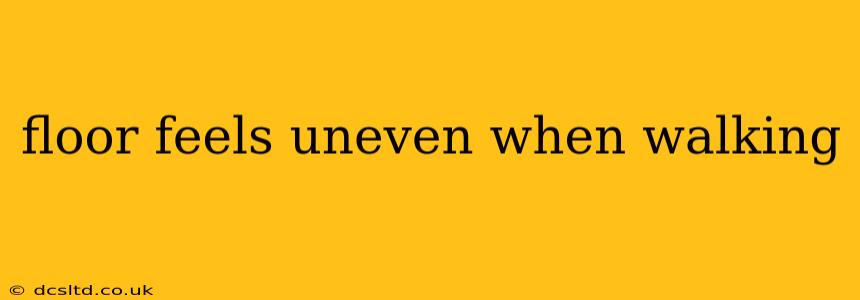Walking on an uneven floor can be unsettling, disruptive, and even dangerous. A seemingly minor imperfection can lead to trips, falls, and long-term back problems. This comprehensive guide will explore the common causes of uneven floors and offer practical solutions to restore a level and safe walking surface.
Why Does My Floor Feel Uneven?
Uneven floors stem from a variety of issues, often interconnected and dependent on the type of flooring and the age of your home. Let's delve into some of the most frequent culprits:
Subfloor Problems
This is often the root cause. The subfloor, the layer beneath your finished flooring, provides the structural base. Problems here can manifest in several ways:
- Sagging Joists: Over time, floor joists (the wooden beams supporting the floor) can weaken and sag, creating unevenness. This is common in older homes or those with inadequate joist support.
- Damaged Subflooring: Water damage, pest infestation (termites, wood-boring insects), or simply age can weaken or damage the plywood or particleboard subfloor, leading to dips and unevenness.
- Improper Installation: If the subfloor wasn't properly installed during construction, it might have gaps, unevenness, or insufficient support from the beginning.
Flooring Issues
The type of flooring itself can also contribute to the uneven feeling:
- Loose or Uneven Tiles: In tile floors, individual tiles can become loose or shift over time, creating a bumpy surface. This can be due to poor installation, settling of the subfloor, or even just the wear and tear of daily use.
- Buckling Hardwood: Changes in humidity can cause hardwood floors to expand and contract, leading to buckling and unevenness. This is a common problem in areas with fluctuating humidity levels.
- Carpet Issues: While carpet might seem to mask unevenness, an uneven subfloor will still be felt beneath it, and the carpet itself can also become uneven due to stretching, wear, or improper installation.
Settling Foundation
In some cases, the unevenness isn't directly related to the floor itself but rather the foundation of the house. Over time, the foundation can settle unevenly, causing the entire floor structure to shift and become uneven. This is a significant issue requiring professional assessment.
How Can I Fix an Uneven Floor?
The solution depends heavily on the cause of the unevenness. Some issues are simple DIY fixes, while others require the expertise of a professional contractor.
Identifying the Problem
Before attempting any repairs, accurately diagnose the source of the unevenness. Carefully inspect the floor, feeling for dips, rises, or soft spots. If you suspect foundation problems, contact a structural engineer immediately.
DIY Solutions for Minor Unevenness
- Leveling Compound: For small dips and imperfections in tile or concrete floors, self-leveling concrete or leveling compound can be a relatively simple DIY solution.
- Loose Tiles: Re-secure loose tiles with appropriate adhesive. If the tile is cracked or broken, replace it.
- Carpet Stretching: If your carpet is uneven, it might require professional stretching.
Professional Help for Significant Unevenness
- Sagging Joists: Fixing sagging joists requires significant structural work, including adding support beams or sistering joists (adding new joists alongside the existing ones). This is best left to experienced contractors.
- Foundation Issues: Foundation problems are serious and should be addressed by a qualified structural engineer and foundation repair specialist. This is often a costly repair.
- Extensive Subfloor Damage: Replacing large sections of damaged subflooring is a major undertaking and requires expertise to ensure the proper installation of new subflooring.
Frequently Asked Questions (FAQs)
How much does it cost to fix an uneven floor?
The cost varies enormously depending on the cause, extent of the damage, and the size of the area needing repair. Minor DIY fixes could cost a few hundred dollars, while major structural repairs could run into the thousands.
Can I fix an uneven floor myself?
For minor issues like loose tiles or small dips, DIY solutions are possible. However, significant structural problems like sagging joists or foundation settling require the expertise of professionals.
What are the signs of a settling foundation?
Signs include cracks in walls or foundation, sticking doors or windows, uneven floors, and gaps appearing around the base of your house.
How can I prevent uneven floors in the future?
Regular maintenance, addressing water leaks promptly, and ensuring proper ventilation to control humidity can all help prevent uneven floors.
Addressing an uneven floor is crucial for safety and comfort. By identifying the cause and employing the appropriate solution, you can restore a level, safe, and enjoyable walking surface in your home. Remember, when in doubt, consult a professional to avoid costly mistakes and ensure the longevity of your floors.
